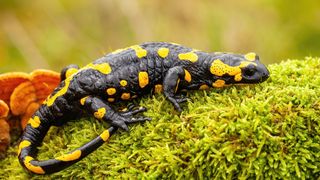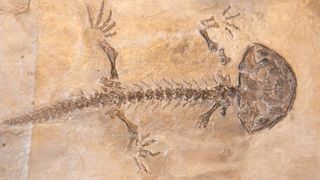Stunning reconstruction of Jurassic salamander fossil reveals skull’s weirdness in 3D
The skull shares similarities with crocodiles, frogs and modern salamanders.

A bizarre, newly discovered species of ancient salamander recently received a digital makeover. Researchers used X-ray images to create a 3D model of the animal's oddly shaped skull, which had been trapped inside a Jurassic rock first uncovered around 50 years ago.
The newly identified species, which scientists named Mamorerpeton wakei, dates to around 166 million years ago, during the Jurassic period (201.3 million to 145 million years ago). Researchers estimated that these ancient salamanders grew to be around 6.3 inches (16 centimeters) long, and the shape and structure of their bones suggested they were an aquatic species that likely swam around ancient ponds or lakes, slurping up smaller creatures with powerful suction.
Part of the ancient amphibian was collected unintentionally in the early 1970s, by another group of researchers on Scotland's Isle of Skye. This team had unearthed a lump of limestone with a single bone protruding from the surface, suggesting that there might be something of interest inside. However, the limestone block was deemed less important than other fossils that were collected at the time, and the limestone — along with its undetermined contents — went into storage. However, another research team uncovered additional fragments of the specimen between 2016 and 2019, suggesting that the long-ignored rock in storage might contain part of the unknown creature's skull.
For the new study, the authors used X-rays to scan the skull block without damaging any of the fragile bones inside. The team generated around 800 individual projections, or images, of the bones inside the block and then used a computer program to reassemble the skull, which had been crushed and mangled inside the rocky matrix, back into its original 3D shape.
Related: 10 coolest non-dinosaur fossils unearthed in 2021
"Initially, we thought the material would represent Mamorerpeton kermacki," an ancient salamander species known from rocks of the same time period in England, lead study author Marc Jones, an evolutionary biologist at University College London, told Live Science in an email. However, the skull reconstruction revealed that it was actually a new species from the same genus, Jones added.
The researchers were surprised to discover just how dramatically the skull differed from those of salamanders alive today.
Sign up for the Live Science daily newsletter now
Get the world’s most fascinating discoveries delivered straight to your inbox.

"There is a lot of variation in skull structure among modern salamanders," Jones said. "But the new fossil salamander is different from all of them." Some of the bones resembled those seen in frogs, and a couple of standout features were crocodile-like structures on the roof of the skull and bony projections behind the eye, both of which are unlike anything seen in modern salamanders. Attachment of the jaw muscles also differed from the jaws of most modern salamanders.
The unusual characteristics of the skull, combined with its salamander-like structures, suggest that M. wakei may have been an evolutionary cousin of many modern salamanders, of which there are around 750 species, according to the study. Previously, other researchers had identified ancient salamanders from the genus Karaurus as the most likely common ancestors of modern salamanders, Jones said. M. wakei and Karaurus show lots of similarities, which hinted that the new species may also be a common ancestor of modern salamanders. But comparisons to a broad sample of amphibians show that neither are the common ancestor of modern salamanders. Instead, these species represent an evolutionary side branch, Jones said. The new discovery shows that salamander evolution is "more complicated than previously assumed," he added.

The researchers said the discovery highlights the importance of assessing all fossil discoveries — even those that initially seem unremarkable. It is "common" for fossils like this to slip under the radar because it can be expensive and time-consuming to analyze them, Jones said. But as technology continues to advance, long-ignored fossils like this one can provide new insight into the evolution of modern creatures, which is "important for understanding why they are the way they are," he added.
The study was published online July 11 in the journal Proceedings of the National Academy of Sciences.
Originally published on Live Science.

Harry is a U.K.-based senior staff writer at Live Science. He studied marine biology at the University of Exeter before training to become a journalist. He covers a wide range of topics including space exploration, planetary science, space weather, climate change, animal behavior, evolution and paleontology. His feature on the upcoming solar maximum was shortlisted in the "top scoop" category at the National Council for the Training of Journalists (NCTJ) Awards for Excellence in 2023.
